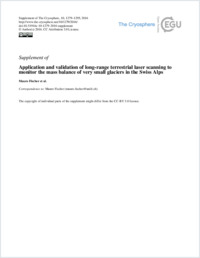Application and validation of long-range terrestrial laser scanning to monitor the mass balance of very small glaciers in the Swiss Alps
- Fischer, Mauro Department of Geosciences, University of Fribourg, Switzerland
- Huss, Matthias Department of Geosciences, University of Fribourg, Switzerland - Laboratory of Hydraulics, Hydrology and Glaciology (VAW), ETH Zurich, Switzerland
- Kummert, Mario Department of Geosciences, University of Fribourg, Switzerland
- Hoelzle, Martin Department of Geosciences, University of Fribourg, Switzerland
-
20.06.2016
Published in:
- The Cryosphere. - 2016, vol. 10, no. 3, p. 1279–1295
English
Due to the relative lack of empirical field data, the response of very small glaciers (here defined as being smaller than 0.5 km²) to current atmospheric warming is not fully understood yet. Investigating their mass balance, e.g. using the direct glaciological method, is a prerequisite to fill this knowledge gap. Terrestrial laser scanning (TLS) techniques operating in the near infrared range can be applied for the creation of repeated high-resolution digital elevation models and consecutive derivation of annual geodetic mass balances of very small glaciers. This method is promising, as laborious and potentially dangerous field measurements as well as the inter- and extrapolation of point measurements can be circumvented. However, it still needs to be validated. Here, we present TLS-derived annual surface elevation and geodetic mass changes for five very small glaciers in Switzerland (Glacier de Prapio, Glacier du Sex Rouge, St. Annafirn, Schwarzbachfirn, and Pizolgletscher) and two consecutive years (2013/14– 2014/15). The scans were acquired with a long-range Riegl VZ®-6000 especially designed for surveying snow- and ice-covered terrain. Zonally variable conversion factors for firn and bare ice surfaces were applied to convert geodetic volume to mass changes. We compare the geodetic results to direct glaciological mass balance measurements coinciding with the TLS surveys and assess the uncertainties and errors included in both methods. Average glacier-wide mass balances were negative in both years, showing stronger mass losses in 2014/15 (−1.65 m w.e.) compared to 2013/14 (−0.59 m w.e.). Geodetic mass balances were slightly less negative but in close agreement with the direct glaciological ones (R² = 0.91). Due to the dense in situ measurements, the uncertainties in the direct glaciological mass balances were small compared to the majority of measured glaciers worldwide (±0.09 m w.e. yr⁻¹ on average), and similar to uncertainties in the TLS-derived geodetic mass balances (±0.13 m w.e. yr⁻¹).
- Faculty
- Faculté des sciences et de médecine
- Department
- Département de Géosciences
- Language
-
- English
- Classification
- Hydrology
- License
- License undefined
- Identifiers
-
- RERO DOC 277686
- DOI 10.5194/tc-10-1279-2016
- Persistent URL
- https://folia.unifr.ch/unifr/documents/305106
Other files
Statistics
Document views: 92
File downloads:
- hoe_avl.pdf: 125
- hoe_avl_sm.pdf: 87

